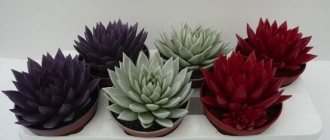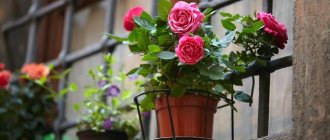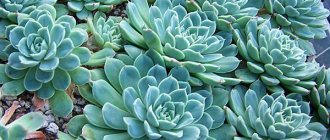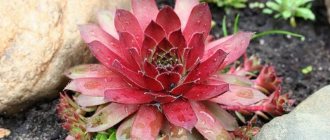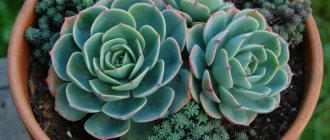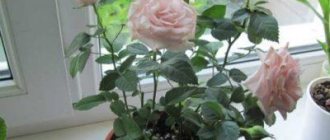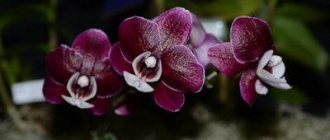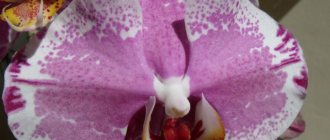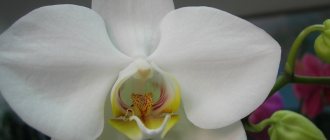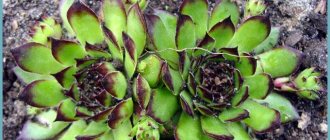Young, popularly called stone rose, is an unpretentious plant that is grown both in the garden and in the apartment. It needs some space and sunlight. Care rules include watering, fertilizing and replanting. Knowing the propagation technology, you can create attractive compositions from several specimens planted in one pot.
The flower is widely used in landscape design. It looks especially impressive on alpine slides, on the banks of reservoirs and waterfalls. When planting, it is important to consider combinations with other crops. Its hardiness and ease of propagation make it popular in various regions.
Introduction to the stone flower
In the 19th century, a book was published called "Flora of Mexico" with illustrations by the artist Anastasio Eccheverria. Of the variety of flowers, a flower resembling a stone rose turned out to be very noticeable and unusual. This is how the plant received its botanical name - echeveria (eccheveria).
Features of Echeveria - stone rose.
Echeveria is also called stone flower or stone rose, due to its neat round rosette of leaves that have different shapes and varied colors. The plant belongs to the genus of succulents and the Crassulaceae family. Its leaves are in the form of a low rosette, the diameter of which is 5-30 cm. In the wild, there are approximately 200 species of echeveria, differing only in the shape and covering of the leaves.
The rosette may consist of flat or convex leaves, have a waxy coating or fluff, with the help of which the plant is protected from sunlight and winter frosts. You can often find a stone rose with purple leaves.
Since the plant first appeared in Mexico, which has many bright and sunny days a year, wild echeveria species have short stems. If you grow a plant indoors, it, deprived of sufficient lighting, stretches out and becomes less decorative.
A related plant, Juvenile, which is common in Europe, the Caucasus and Asia, is often mistaken for echeveria. It is also called stone rose and the plants are very similar in appearance. Juvenile is more frost-resistant, so it is not even grown indoors. Echeveria can die if the air temperature is below 6 degrees above zero. In addition, juveniles do not have stems.
Types and varieties
Science knows more than 50 subspecies of the flower. The main ones are 12 plant species. In addition to the already mentioned roofing, there are such varieties and types with names in Latin:
- Young offspring (sempervivum soboliferum).
- Calcareous young (sempervivum calcareum).
- Rejuvenated cobwebby sempervivum arachnoideum. Spider-like shoots on reddish leaves.
- Juvenile grandiflora (sempervivum grandiflorum).
- Mpython got colder (sempervivum pittonii).
- The Russian was rejuvenated (sempervivum ruthenicum). Green leaves with red tip.
- Juvenile ball-bearing (sempervivum globiferum). Bright green rosettes with redness when young.
- Marble rejuvenated (sempervivum marmoreum). Burgundy color of the plant.
- Young young undersized or dwarf (sempervivum pumilum). Dark green color without redness.
- Rejuvenated Caucasian (sempervivum caucasicum).
- Young Wulfen (sempervivum wulfenii). Shiny green leaves with a red base.
By the way, flower growers call it Sempervivum by analogy with the Latin name.
Interesting! All types of plants are suitable for both growing at home on a windowsill and for planting in household plots! To choose the flower that suits you, look at the description and pictures for the query “rejuvenated photo”.
The most beautiful of these types: calcareous, cobwebby and marble . These varieties are most often used for growing indoors. These same species are popular with many gardeners. The plant is loved because planting and caring for it at home does not require special knowledge and skills.
It is unpretentious, there is even a joke about this: “the worse, the better.” All other types are options for open ground. The least common varieties used in floriculture are: wulfena, scion, python - the least common varieties of juveniles.
This video tells about the young plant and the features of its cultivation.
Varieties of rock rose
There are, as mentioned above, about 200 species of echeveria. If we consider miniature plant species with a stem less than 10 cm long, the most common varieties are:
- Echeveria graceful, which has a light green rosette of leaves and a peduncle, the flowers of which are red-yellow.
- Echeveria Derenberg produces beautiful orange flowers and leaves with red edges.
- Echeveria bristlecone is a miniature plant with leaves covered with white bristles.
Varieties and types of stone flower.
The varieties of the most common tall-stemmed rock roses are as follows:
- Echeveria is purple, has a strong stem, at the very top of which you can see a rosette collected with pubescent leaves. The flowers are red, with yellow edges.
- Echeveria hump-flowered is distinguished by a strong stem, the growth of which is up to 65 cm.
- The most frost-resistant is Echeveria blue.
In addition to the listed plant species, nature and people have created many other types of stone roses that are beautiful in shape and color.
Description of young
Juvenile is a perennial with fleshy stems and leaves. Its foliage forms a rosette, which resembles a rosebud or a head of cabbage. The diameter of such a rosette can reach up to 15 cm, but there are also tiny species in which it does not exceed 1 cm. The shape and color of the foliage of the juvenile varies significantly depending on the type and variety of the plant. Leaf blades can be short or long, pointed or rounded at the end. Their main color is most often green, but can be complemented by many other colors: red, brownish, pink or white. There are also completely colored juveniles. Some varieties can change color from season to season. The color of plants can also vary depending on the degree of illumination. Some species may have pubescence on the leaves.
Juvenile is considered a ground cover. The overgrown plantings of this plant resemble a continuous carpet of rosettes. This property allows you to use a miniature “rose” in landscape design to decorate the site. Rosettes also grow successfully in pots: such plantings require little space.
In addition to decorative foliage, young plants can also delight with their flowers. Flowering occurs only in adult rosettes older than 3 years. During this period, quite large shoots-peduncles grow on them, on which bright flowers of various colors bloom within a couple of months. Typically, juveniles bloom in the summer. But each rosette can bloom only once in its life. After this, it dies off, having managed to form one or several rosettes.
The most beautiful unpretentious perennial - rejuvenated
Conditions for normal development and growth of echeveria
With proper care, it is necessary to provide the following conditions for the plant:
- Lighting. At any time of the year there should be enough bright light and direct rays of the sun. It is not advisable to place pots with plants on window sills facing north.
- Glaze. In winter and autumn, you need to water the plant moderately, once a month. In spring and summer, water it more often - when the earthen ball dries out completely. It turns out once every 10 days.
- Air humidity. Spraying the outlet is not required at any time of the year.
- Temperatures. In winter and autumn, the air temperature in a cool room should not fall below +10 degrees. In summer and spring, the temperature should be 22-27 degrees above zero.
Features of the correct growth and development of a stone rose.
Planting and replanting stone roses
When purchasing plants, try to ensure that the bushes you buy are healthy, the rosettes are compact, so that the plants are not elongated and do not suffer from any disease. Since the bulk of the plants are grown by sellers in a peat mixture, it is recommended to replant newly purchased echeveria immediately into loose and light soil for succulents.
Echeveria has a shallow root system, so you should not use deep pots to grow it - a wide, flat container will do. The bottom of the container should have enough drainage holes and a drainage layer that includes pebbles, broken bricks or expanded clay. The layer should not be less than 2 cm thick.
For growing the plant, light soil for cacti and succulents is most suitable. It is allowed to prepare the soil with your own hands. To do this, mix the following composition:
- Sod land - 3 parts.
- Sand – 1 part.
- Small expanded clay – 1 part.
Before planting echeveria, it is necessary to disinfect the soil. This can be done by pouring boiling water over it and then cooling. Young plants are replanted every spring. The same soil is used, but replanting is done in wider pots (a couple of centimeters wider).
How to plant and replant a stone rose.
By replanting, you can also start propagating the plant. This is done by cutting off the lateral daughter rosettes and mature leaf blades.
Transfer
After purchase, you need to let Molodilo stand for 10-14 days separately from other plants, to get used to the new room and its conditions. And then start transplanting.
We prepare the necessary:
- wide pot - remember that the stone rose reproduces with “tendrils” along the edges, so choose a container larger than the diameter of the rosette;
- drainage - expanded clay or small stones;
- soil - you can buy ready-made for succulents or make your own. Stone rose loves loose, rocky, sandy soil. Each gardener has his own “recipe” for soil, some plant simply in rock soil;
- plant - we tear off the dried leaves from below, empty and rotten roots, if any.
Next, we proceed directly to transplanting the plant :
- place drainage on the bottom of the pot (about ⅓ of the container);
- pour soil, make a small hole with your fingers;
- we plant our Young and sprinkle soil around the edges;
- It’s better to refrain from watering; you’ll do it in a few days.
Florarium decoration
A beautiful and original composition can be created using several miniature succulents in a florarium. It can be created independently or purchased ready-made. The composition can be composed of various types of echeveria, cacti, Kalanchoe, young plants and other plants.
Work on creating a composition is carried out in the following order:
- First, the glass container is disinfected with alcohol.
- Fine drainage is poured onto the bottom of the container in a layer a quarter of its height, on top - a layer of soil of the same thickness, lightly compact both layers.
- It is imperative to have a drainage layer at the bottom of the container, even if it is small and small plants are planted.
- Next, plants are placed on the ground, the roots of which are lightly sprinkled with soil, which is carefully compacted.
- Pre-boiled and cooled decorative pebbles and sand are laid out on the ground (colored sand will look more beautiful). You can also put special stones for the aquarium.
- If the top layer of the florarium will be soil for the aquarium, it is better to use colored soil - it will turn out very beautiful.
- All that remains is to decorate the composition by installing figurines or floral decorative elements.
Decorating a florarium using a stone rose.
The place for the florarium should be brightly lit. The composition should be watered rarely, even less often than an echeveria growing in an open pot is watered; the soil should not become waterlogged.
If the container and soil are not disinfected, the plants may be affected by fungal infections, which quickly develop in the limited space of the florarium.
Growing a flower in open ground
Initially, young was an open ground plant, so it is freely grown in flower beds, rock gardens, alpine hills, and also in various flowerpots in the country.
How to plant a stone rose (seeds and vegetatively)
In open ground, sowing can be done when the soil warms up to 20 °C, only then after 14 days will seedlings appear. Since young seedlings are very small in size and grow extremely slowly, the seed method for open ground is rarely used, giving preference to cutting and planting daughter rosettes. Rooting usually takes only 2 weeks.
Stone rose seedlings
Note! The best time for sowing seeds is June, and for planting rosettes cut from an adult plant, late spring, all summer and even September are suitable.
Selecting a location
The place for the stony rose should be illuminated throughout the day. It is best to choose an elevated site to eliminate the possibility of moisture accumulating at the roots.
How to prepare the soil and flower for planting
Loose soil containing little humus is suitable for planting. It is best to additionally add sand and crushed charcoal for better aeration. The sockets themselves do not require preliminary preparation.
Step by step landing procedure
The order of planting sockets is as follows:
- Using a sharp knife, cut the young rosettes from the mother plant, leaving a petiole 5-10 mm long.
- Immediately prepare the site for planting by thoroughly loosening the soil on it.
- Plant rosettes, leaving 10-15 cm between them.
- Water the rose stone very carefully to only slightly moisten the soil. The next watering is needed no earlier than 7 days later.
How to properly care for a stone rose
Echeveria is a rather finicky plant that requires special care.
Optimal lighting and temperature values
The most important factor for normal growth and development of plants is a sufficient amount of sunlight. The stone rose must receive a lot of light in summer and winter, otherwise it will cease to be an ornamental plant.
Proper care of a stone rose.
But air temperature is not a very important parameter for echeveria. In winter, it is better that the temperature is no higher than +15 degrees, however, lower temperatures are also allowed, but not less than 6 degrees above zero.
In the summer, take the plant to the balcony so that it stands in direct sunlight - echeveria is not afraid of burns, since it is protected by a waxy coating or pubescence of the leaves.
How to properly water and fertilize echeveria
Feeding the stone rose is carried out once a month in spring and summer. For this purpose, special fertilizers for cacti and succulents , which are applied according to the instructions. In the autumn and winter seasons, fertilizing is not done.
In summer, echeveria requires frequent watering. It is advisable to use the bottom watering method using a tray. It is not recommended to get liquid on the leaves.
In winter, when the room temperature drops and the plants do not receive enough sunlight, watering is reduced - no more than once a month.
Rejuvenation in landscape design
The original and attractive appearance of stone rose rosettes makes it an excellent component of many garden plans. One of the most popular solutions is to plant juveniles among stones. You can surround a large stone with rosettes and use them to decorate a rock garden or rock garden.
With the help of such plantings you can frame garden paths and stairs, as well as decorate garden figures. Juveniles planted in pots are also suitable for beautifying the site. They are arranged as effectively as possible, creating different patterns from plants. Today, low roofs of houses or barns are often turned into abode for ground cover, including using young plants for this purpose.
The young plant can fit perfectly into an ordinary flower bed. But they try to plant it next to the same low plants, which will not block the sunlight from the “stone rose”. Usually they try to combine it with saxifrage, sedum or mosses. You can create a composition from different types of juveniles. Thanks to their compact roots, rosettes can be planted in literally any container, using old garden tools (buckets, pots) or special flowerpots.
My Rejuvenated collection: 40 varietal stone roses.
Dormancy and flowering periods
Echeveria does not have a dormant period; the plant simply slows down its growth in the winter. If you want to stimulate flowering, you can give the stone rose a rest in the autumn-winter period - put the plants in a cool room and do not water them.
Does the stone rose bloom?
Echeveria blooms most often in the summer. It produces one or more peduncles, the flowers of which are bell-shaped. If you do not want to collect seeds, it is recommended to remove the flower stalk after the plant has finished flowering, otherwise the flower will become depleted.
Mistakes when caring for a plant
Improper care of echeveria leads to errors that need to be eliminated.
With a lack of lighting: the shoots stretch out, the decorative effect is lost. To correct this drawback, you need to place the plant on a bright windowsill and illuminate it with fluorescent lamps or phytolamps.
With a lack of moisture: the leaves begin to wither and wrinkle. It is necessary to increase watering.
As the plant ages, the lower leaves begin to turn yellow. This is a natural process for the flower - the dried lower leaves are simply removed.
With excess moisture: leaves become swollen, yellow and watery. It is urgent to inspect the roots of the plant and the soil, transplant the echeveria into another soil, which should be air-intensive, and adjust the watering.
Control of diseases and pests of stone rose
Echeveria is rarely affected by pests. However, it happens that the plant is affected by mealybugs, which damage the leaf blades and eat up the root system. The pest is easy to recognize - its colonies look like dirty cotton wool on the leaves of the plant.
They are removed using alcohol-soaked cotton swabs. You can wash off the pests with soap suds. If the case is complex and neglected, the plant and soil are sprayed with insecticides - Aktara and Fitoverm are most often used.
When a succulent is waterlogged or the soil is affected by a fungal infection , the plant withers and rots. You can get rid of this disease only at the beginning of infection. The drugs Fitosporin or Trichodermin, used strictly according to the instructions, will help with this. However, the disease is detected late, when it can no longer be saved.
How does echeveria reproduce?
The simplest and most reliable way to propagate echeveria is to separate the lateral daughter rosettes from the mother bush. This is done during plant transplantation in the spring. The rosettes are cut with a knife, which must first be sterilized, then each cut must be sprinkled with activated carbon powder, dried and planted in the ground the next day.
Rules and features of stone rose propagation.
Reproduction
Experienced gardeners prefer to propagate young plants using daughter shoots. They are carefully cut from the mother plant with a sharp, disinfected knife and planted in a small container. It is better to do this in the spring, but if such a need arises, you can propagate the plant in the fall and summer.
Seed propagation is considered more labor-intensive and time-consuming. In early spring, the seeds are laid out on the surface of moistened soil, sprinkled with a thin layer of soil or peat and covered with film. After two weeks at a temperature of +20 °C, the first shoots will appear.
Propagation using leaf or apical cuttings
When, for various reasons, a stone rose does not produce children, it can propagate using cuttings: apical or leaf. Actions are performed in the following sequence:
- A young leaf located close to the trunk is cut off from the mother bush, or the top of the stem is cut off, and several leaves located at the bottom of the stem are removed.
- The cuttings are dried for several hours.
- Then the lower part of the leaf or stem cutting is immersed in a moistened mixture of vermiculite and sand.
- The cutting is installed in a place that is brightly lit. The soil is periodically sprayed.
- A month later, after the roots appear, new rosettes develop.
- This process takes from 2 to 3 months. During this period of time, wrinkling and drying of the mother leaf occurs.
- The grown young rosette is transplanted into a wide pot filled with soil for cacti.
Requirements for soil and planting site
This extremely hardy plant can grow almost anywhere as long as it is sunny and dry. First of all, the young need light - full sun without any restrictions. The sunny the position, the more beautifully colored the leaves of the rosette are. The specificity of the substrate is a secondary matter for them. They can even be grown on roofs and walls.
Juvenile prefers soils:
- not very fertile;
- permeable;
- quite dry.
On the contrary, it does not tolerate soil:
- heavy;
- clayey;
- wet.
Juveniles planted in poorly drained soil will quickly begin to wither. Therefore, it is worth preparing a mixture of lumpy earth, gravel and stones. When growing in pots, you need to put in more effort and purchase a special substrate for succulents that guarantees perfect drainage and a pH level of about 6. The substrate can be mixed with crushed limestone.
Germinating rock rose seeds
If echeveria is grown from seeds purchased in specialized stores, problems, as a rule, do not arise. They are germinated as follows:
- Plant the seeds in soil consisting of peat and sand. They should be deepened by 4-5 mm.
- Then you need to water the soil with water from a spray bottle and place the container under the film.
- The resulting greenhouse is placed in a warm and bright room, the temperature in which is 20-25 degrees. It is necessary to periodically spray the soil with water and ventilate the room daily for 30 minutes.
- Sprouts appear within 2 weeks.
- When 2-3 true leaves appear, the seedlings can be transplanted into separate pots.
Echeveria, which is propagated by seed, blooms in the 3rd or 4th year.
Echeveria is a spectacular indoor plant that will delight you with its beauty and decorativeness when given enough light. Decorative original rosettes of leaves have different colors, shapes and colors.
Due to its unpretentiousness, this plant is very popular among busy people and fans of succulents and flower decorators who create stylish compositions in the florarium.
